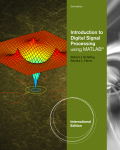
Introduction to digital signal processing using MATLAB
This second edition text focuses on the fundamentals of digital signal processing with an emphasis on practical applications. In order to motivate students, many of the examples illustrate the processing of speech and music. This theme is also a focus of the course software that features facilities for recording and playing sound on a standard PC. The accompanying website contains a comprehensive MATLAB software package called the Fundamentals of Digital Signal Processing (FDSP) toolbox version 2.0. The FDSP toolbox includes chapter GUI modules, an extensive library of DSP functions, all computational examples that appear in the text, the text figures, solutions to selected problems, and online help documentation. Using the interactive GUI modules, students can explore, compare, and directly experience the effects of signal processing techniqueswithout any need for programming. INDICE: PART I. SIGNAL AND SYSTEM ANALYSIS. 1. SIGNAL PROCESSING. Motivation. Signals and Systems. Sampling of Continuous-time Signals. Reconstruction of Continuous-time Signals. Prefilters and Postfilters. DAC and ADC Circuits. The FDSP Toolbox. GUI Software and Case Studies. Chapter Summary. Problems. 2. DISCRETE-TIME SYSTEMS IN THE TIME DOMAIN. Motivation. Discrete-time Signals. Discrete-time Systems. Difference Equations. Block Diagrams. The Impulse Response. Convolution. Correlation. Stability in the Time Domain. GUI Software and Case Studies. Chapter Summary. Problems. 3. DISCRETE-TIME SYSTEMS IN THE FREQUENCY DOMAIN Motivation. Z-transform Pairs. Z-transform Properties. Inverse Z-transform. Transfer Functions. Signal Flow Graphs. Stability in the Frequency Domain. Frequency Response. System Identification. GUI Software and Case Studies. Chapter Summary. Problems. 4. FOURIER TRANSFORMS AND SIGNAL ANALYSIS. Motivation. Fourier Series. Discrete-time Fourier Transform (DTFT). Discrete FourierTransform (DFT). Fast Fourier Transform (FFT). Fast Convolution and Correlation. White Noise. Auto-correlation. Zero Padding and Spectral Resolution. The Spectrogram. Power Density Spectrum Estimation. GUI Software and Case Studies. Chapter Summary. Problems. PART II. DIGITAL FILTER DESIGN. 5. FILTER DESIGN SPECIFICATIONS. Motivation. Frequency-selective Filters. Linear-phase Filters. Minimum-phase and Allpass Filters. Quadrature Filters. Notch Filters and Resonators. Narrowband Filters and Filter Banks. Adaptive Filters. GUI Software and Case Study. Chapter Summary. Problems. 6. FIR FILTER DESIGN. Motivation. Windowing Method. Frequency-sampling Method. Least-squares Method. Equiripple Filters. Differentiators and Hilbert Transformers. Quadrature Filters. Filter Realization Structures. Finite Word Length Effects. GUI Software and Case Study. Chapter Summary. Problems. 7. IIR FILTER DESIGN. Motivation. Filter Design by Pole-zero Placement. Filter Design Parameters. Classical Analog. Bilinear Transformation Method. Frequency Transformations. Filter Realization Structures. Finite Word Length Effects. GUI Software and Case Study. Chapter Summary. Problems. PART III. ADVANCED SIGNAL PROCESSING. 8. MULTIRATE SIGNAL PROCESSING Motivation. Integer Sampling Rate Converters. Rational Sampling Rate Converters. Multirate Filter Realization Structures. Filter Banks and Subband Processing. A Two-channel QMF Bank. Oversampling ADC. Oversampling DAC. GUI Software and CaseStudy. Chapter Summary. Problems. 9. ADAPTIVE SIGNAL PROCESSING. Motivation. Mean Square Error. The Least Mean Square (LMS) Method. Performance Analysis ofthe LMS Method. Modified LMS Methods. Adaptive FIR Filter Design. The Recursive Least Squares (RLS) Method. Active Noise Control. Nonlinear System Identification. GUI Software and Case Study. Chapter Summary. Problems. REFERENCES ANDFURTHER READING APPENDICES Transform Tables. Mathematical Identities. FDSP Toolbox Functions.
- ISBN: 978-1-111-42602-6
- Editorial: Cengage Learning Services
- Encuadernacion: Desconocida
- Fecha Publicación: 27/03/2011
- Nº Volúmenes: 1
- Idioma: Inglés
